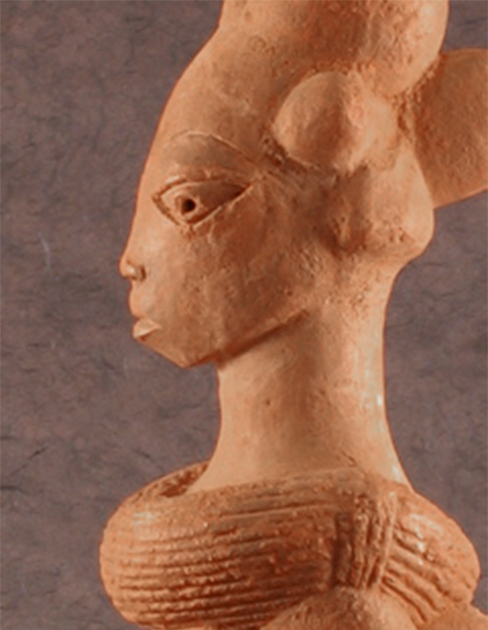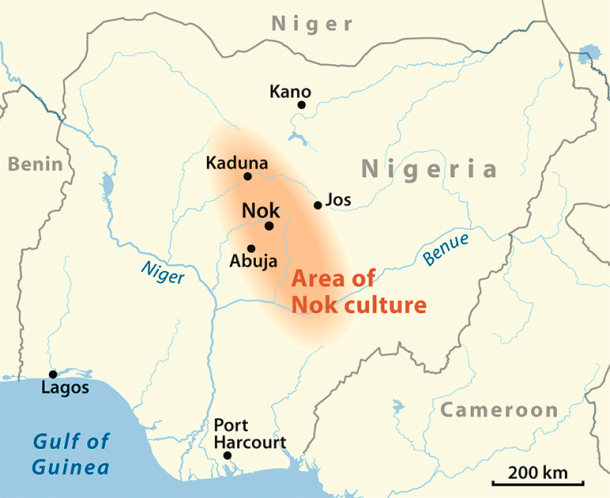The remarkable civilization of the Nok was first discovered in 1928 when a wealth of unique terracotta artifacts was unearthed by tin miners in the southern part of Kaduna state in central Nigeria. Since then, extensive archaeological excavations and research into the Nok have revealed that they may have been one of the first complex civilizations in West Africa, existing from at least 900 BC until their mysterious disappearance in around 200 AD.
The Nok were an extremely advanced society, with one of the most complex judicial systems of the time, and the earliest producers of life-sized terracotta in the Sub-Sahara. Archaeologists have also found stone tools, rock paintings and iron implements, including fearsome spear points, bracelets, and small knives.
Terracotta Statues
By far the most enigmatic and intriguing aspect of the Nok Culture were their Terracotta statues, described by the mémoire d’afrique, which houses a gallery of the statues, as “extraordinary, astonishing, ageless, timeless and almost extraterrestrial”.
The figures, which date back to at least 500 BC, are almost always people with large, mostly elongated heads with almond-shaped hollow looking eyes are parted lips. These unusual features are particularly perplexing considering that the statues have been constructed accurately with relative proportions of the head, body and feet, leading some to use the term ‘extraterrestrial-looking’ when describing them.

Nok terracotta figurine ( CC by SA 3.0 )
Some pottery figures from the Nok culture seem to depict individuals with physical conditions such as elephantiasis or facial paralysis. The exact purpose of these “diseased” depictions remains unknown. It is possible that they were intended to serve as protective talismans against illness, but this is still speculation.
Microscopic inspection of the clay used in the terracotta shows it to be remarkably uniform over the whole Nok area, suggesting that the clay came from a single, yet-undiscovered source. Not much is known about the purposes of these peculiar sculptures, but some theories have suggested they were used as charms to prevent crop failure, illness and infertility, while others have suggested that they represent high status individuals who were worshipped by the people.
However, the construction of life-sized statues isn’t the only evidence of the advancement of their society. Research has revealed that the Nok people had a highly developed system of administration to ensure law and order.

Area of the Nok culture ( CC by SA 30 )
Advanced Metalworking
The Nok civilization is well known for its impressive metalworking skills, which were highly advanced for their time. The Nok people crafted intricate objects using iron and copper alloys, creating weapons, tools, and adornments. Their metalworking techniques included casting, forging, and welding, which allowed them to produce objects of various sizes and complexities. Many of their metal objects were decorated with intricate patterns and designs, such as geometric shapes and stylized animals, showcasing their artistic abilities. The Nok metalworking was not only functional but also aesthetically pleasing.
The Nok people’s metalworking skills were also an important factor in their economy and social status. They traded their metal objects with neighboring communities, which helped to establish their reputation as skilled craftsmen. The ability to produce iron tools and weapons gave the Nok people an advantage over their neighbors, allowing them to clear more land for farming and defend their communities. The production of metal objects also played a significant role in the development of social hierarchy, as those with access to metal objects were seen as more powerful and important in society.
Judicial System
It is a known fact that the Nok’s judicial system pre-dates the western judicial system. The Nok people created classes of courts used for adjudicating cases from minor civil cases, such as family disputes and false allegations, to criminal cases such as stealing, murder and adultery. The people believed that every crime attracts a curse which was capable of destroying whole family and therefore must be uncovered to avoid the consequences.
The suspect was brought before an open court for traditional oath taking, which involved standing between two monoliths facing the sun, the most supreme god called Nom. The suspect then swore to tell the truth. Cases that cannot be resolved in the open court are taken to the high court which sits within an enclosed shrine.
The court was presided over by the Chief Priest and various clan heads. Anyone found guilty was fined goats and chicken for sacrifice to the gods and local wine for the chief priest. The town would then declare a day of celebration on which the people would thank the gods for their graces in successfully resolving the issue and averting doom for the people.
Mysterious Disappearance
A sharp drop in the volume of pottery and terracotta in soil layers suggests that the once-thriving Nok population declined fairly rapidly and no evidence can be found of their existence after 200 AD, nor has any evidence been found which suggests a reason for their disappearance. Some have suggested that overexploitation of natural resources and a heavy reliance on charcoal may have played a role, while others have said it could have been any number of different possibilities including climate change, a pandemic, invasion, epidemic or famine.
The Nok civilization left a remarkable cultural legacy for the people that followed after them, but there are still many unanswered questions about the Nok, from why they disappeared to the true purpose and nature of the unique and mysterious terracotta statues.
Top image: Terracotta statues made by the Nok. (Public Domain)
References
Getz, T. Ancient Agrarian Societies: Nok Society . Available at: https://www.khanacademy.org/humanities/whp-origins/era-3-cities-societies-and-empires-6000-bce-to-700-c-e/33-comparing-early-agrarian-societies-betaa/a/read-ancient-agrarian-societies-nok-society-beta
Metropolitan Museum of Art. 2000. Nok Terracottas . Available at: https://www.metmuseum.org/toah/hd/nok/hd_nok.htm
National Geographic. The Nok Culture . Available at: https://education.nationalgeographic.org/resource/nok-culture/
Related posts:
Views: 0
 RSS Feed
RSS Feed
















 March 6th, 2023
March 6th, 2023  Awake Goy
Awake Goy  Posted in
Posted in  Tags:
Tags: 
















